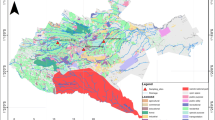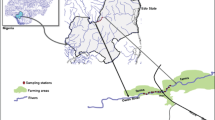Abstract
Keoladeo National Park (KNP) is an important wintering ground for thousands of birds that undertake a perilous journey over the Himalaya to make a seasonal home in a wetland ecosystem. However, this wetland is now getting polluted by various types of contaminants such as pesticides because of the agricultural practices in the catchment area from where the park receives water. Keeping this in mind, the present study has been undertaken to assess the organochlorine pesticide (OCP) residues in the sediments inside and around KNP. Samples were collected from the different blocks of the park. The concentrations of α-HCH, β-HCH, γ-HCH, δ-HCH, S-HCH, aldrin, dieldrin, heptachlor, hept.epoxide, endosulfan-I, endosulfan-II, endo.sulfate, S-endosulfan, endrin, 4,4′-DDE, 4,4′-DDD, and DDT were quantified using gas chromatography with electron capture detection. Analysis showed that the samples were contaminated with the above mentioned pesticides and that the concentration of total OCPs in the sediments varied from 0.1173 (dieldrin) to 5.558 ppm (γ HCH) in the samples collected from inside the park, whereas a range of pesticides varying in concentration from 0.1245 (4,4′-DDD) to 7.54 ppm (γ HCH) was found in samples from outside the park. Residues of S-HCH and S-endosulfan were not detected in any of the sediment samples. The occurrence of pesticides inside the park is a major threat to the park’s biodiversity. Eco-friendly agriculture practices with minimal use of inorganic chemicals are suggested to minimize the pesticide residue levels in the park.



Similar content being viewed by others
References
APHA. (1998). Standard methods for the examination of water and wastewater (20th ed.). Washington: American Public Health Association.
Barlas, N. E. (1999). Determination of organchlorine pesticide residues in aquatic system and organisms in Upper Sakarya BasinTurkiye. Bulletin of Environmental Contamination and Toxicology, 62, 278–285.
Goncalves, C., Carvalho, J. J., Azenha, M. A., & Alpendurada, M. F. (2006). Optimization of supercritical fluid extraction of pesticide residues in soil by means of central composite design and analysis by gas chromatography-tandem mass spectrometry. Journal of Chromatography A, 1110, 6–14.
Hussain, A., Westbom, R., Megersa, N., Mathiasson, L., & Bjorklund, E. (2007). Selective pressurized liquid extraction for multi-residues analysis of organochlorine pesticides in soil. Journal of Chromatography A, 1152, 247–253.
Jiang, Y. F., Wang, X. T., Jia, Y., Wang, F., Wu, M. H., Sheng, G. Y., & Fu, J.M. (2009). Occurrence, distribution and possible sources of organochlorine pesticides in agricultural soil of Shanghai, China. Journal of Hazardous Materials, 170(2–3), 989–997.
Kumari, B., Madan, V. K., & Kathpal, T. S. (2007). Status of insecticide contamination of soil and water in Haryana, India. Environmental Monitoring and Assessment, 136(1–3), 239–244.
Lee, K. T., Tanabe, S., & Koh, C. H. (2001). Distribution of organochlorine pesticides in sediments from Kyeonggi Bay and nearby areas, Korea. Environmental Pollution, 114, 207–213.
Li, M. (1975). Pollution in nation’s estuaries originating from the agricultural use of pesticides. In: Estuarine Pollution Control and Assessment, Proceedings of a conference, 451–466. Washington, DC: US EPA, Office of Water Planning and Standards.
Li, X. D., Mai, B. X., Zhang, G., Sheng, G. Y., Fu, J. M., Pan, S. M., et al. (2001). Distribution of organochlorine pesticides in a sediment profile of the Pearl River estuary. Bulletin of Environmental Contamination and Toxicology, 67, 871–880.
Muralidharan, S. (1993). Aldrin poisoning of sarus carnes (Grus antigone) and a few granivorous birds in Keoladeo National Park, Bharatpur, India. Ecotoxicology, 2, 196–202.
Muralidharan, S. (2000). Organochlorine residues in the waters of Keoladeo National Park. Bulletin of Environmental Contamination and Toxicology, 65, 35–41.
Nhan, D. D., Carvalho, F. P., Nguyen, M. A., Tuan, N. Q., Yen, N. T. H., Villeneuve, J. P., & Catlini, C. (2001). Chlorinated pesticides and PCBs in sediments and mollusks from freshwater canals in the Hanoi region. Environmental Pollution, 112, 311–320.
Oldal, B., Maloschik, E., Uzinger, N., Anton, A., & Szekacs, A. (2006). Pesticide residues in Hungarian soil. Geoderma, 135, 163–178.
Prakash, O., Suar, M., Raina, V., Dogra, C., Pal, R., & Lal, R. (2004). Residues of hexachlorocyclohexane isomers in soil and water samples from Delhi and adjoining areas. Current Science, 87(1), 73–77.
Ramesh, A., Tanabe, S., Murase, H., Subramanian, A. N., & Tatusukawa, R. (1991). Distribution and behavior of persistent organochlorine insecticides in paddy soil and sediments in the tropical environment: a case study in south India. Environmental Pollution, 74, 293–307.
Shegunova, P., Klanova, J., & Holoubek, I. (2007). Residues of organochlorinated pesticides in soils from the Czech Republic. Environmental Pollution, 146, 257–261.
Singh, R. P. (2001). Comparison of organochlorine pesticide levels in soil and ground water of Agra, India. Bulletin of Environmental Contamination and Toxicology, 62, 55–62.
Singh, P. P., Battu, R. S., & Kalra, R. L. (1988). Insecticide residues in wheat grains and straw arising from their storage in premises treated with BHC and DDT under malaria control program. Bulletin of Environmental Contamination and Toxicology, 40, 696–702.
Wang, X., Wang, D., Qin, X., & Xu, X. (2008). Residues of orgenochlorine pesticides in surface soils from college school yards in Beijing, China. Journal of Environmental Sciences, 20(9), 1090–1096.
Yuan, D., Yang, D., Wade, T. L., & Qian, Y. (2001). Status of persistent organic pollutants in the sediment from several estuaries in China. Environmental Pollution, 114, 101–111.
Acknowledgments
We thank the Ministry of Environment and Forests, Government of India for providing funding support for research project “Effect of pesticide use on Indian blue peafowl and Grey francolin in parts of central India” to the World Pheasant Association (WPA)-India. We thank the Director, Wildlife Institute of India for providing support under the UNF-UNESCO project “Building Partnerships to Support UNESCO’s World Heritage Programme in India.” We are grateful to the Director, Keoladeo National Park, Bharatpur for facilitating the conduct of the study.
Author information
Authors and Affiliations
Corresponding author
Rights and permissions
About this article
Cite this article
Bhadouria, B.S., Mathur, V.B. & Kaul, R. Monitoring of organochlorine pesticides in and around Keoladeo National Park, Bharatpur, Rajasthan, India. Environ Monit Assess 184, 5295–5300 (2012). https://doi.org/10.1007/s10661-011-2340-z
Received:
Accepted:
Published:
Issue Date:
DOI: https://doi.org/10.1007/s10661-011-2340-z




